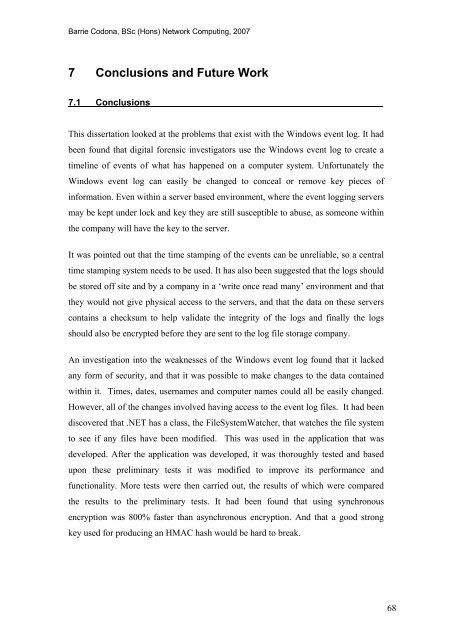Analysis and Evaluation of the Windows Event Log - Bill Buchanan
Analysis and Evaluation of the Windows Event Log - Bill Buchanan
Analysis and Evaluation of the Windows Event Log - Bill Buchanan
You also want an ePaper? Increase the reach of your titles
YUMPU automatically turns print PDFs into web optimized ePapers that Google loves.
Barrie Codona, BSc (Hons) Network Computing, 2007<br />
7 Conclusions <strong>and</strong> Future Work<br />
7.1 Conclusions<br />
This dissertation looked at <strong>the</strong> problems that exist with <strong>the</strong> <strong>Windows</strong> event log. It had<br />
been found that digital forensic investigators use <strong>the</strong> <strong>Windows</strong> event log to create a<br />
timeline <strong>of</strong> events <strong>of</strong> what has happened on a computer system. Unfortunately <strong>the</strong><br />
<strong>Windows</strong> event log can easily be changed to conceal or remove key pieces <strong>of</strong><br />
information. Even within a server based environment, where <strong>the</strong> event logging servers<br />
may be kept under lock <strong>and</strong> key <strong>the</strong>y are still susceptible to abuse, as someone within<br />
<strong>the</strong> company will have <strong>the</strong> key to <strong>the</strong> server.<br />
It was pointed out that <strong>the</strong> time stamping <strong>of</strong> <strong>the</strong> events can be unreliable, so a central<br />
time stamping system needs to be used. It has also been suggested that <strong>the</strong> logs should<br />
be stored <strong>of</strong>f site <strong>and</strong> by a company in a ‘write once read many’ environment <strong>and</strong> that<br />
<strong>the</strong>y would not give physical access to <strong>the</strong> servers, <strong>and</strong> that <strong>the</strong> data on <strong>the</strong>se servers<br />
contains a checksum to help validate <strong>the</strong> integrity <strong>of</strong> <strong>the</strong> logs <strong>and</strong> finally <strong>the</strong> logs<br />
should also be encrypted before <strong>the</strong>y are sent to <strong>the</strong> log file storage company.<br />
An investigation into <strong>the</strong> weaknesses <strong>of</strong> <strong>the</strong> <strong>Windows</strong> event log found that it lacked<br />
any form <strong>of</strong> security, <strong>and</strong> that it was possible to make changes to <strong>the</strong> data contained<br />
within it. Times, dates, usernames <strong>and</strong> computer names could all be easily changed.<br />
However, all <strong>of</strong> <strong>the</strong> changes involved having access to <strong>the</strong> event log files. It had been<br />
discovered that .NET has a class, <strong>the</strong> FileSystemWatcher, that watches <strong>the</strong> file system<br />
to see if any files have been modified. This was used in <strong>the</strong> application that was<br />
developed. After <strong>the</strong> application was developed, it was thoroughly tested <strong>and</strong> based<br />
upon <strong>the</strong>se preliminary tests it was modified to improve its performance <strong>and</strong><br />
functionality. More tests were <strong>the</strong>n carried out, <strong>the</strong> results <strong>of</strong> which were compared<br />
<strong>the</strong> results to <strong>the</strong> preliminary tests. It had been found that using synchronous<br />
encryption was 800% faster than asynchronous encryption. And that a good strong<br />
key used for producing an HMAC hash would be hard to break.<br />
68










![Unit 5. Switches and VLANs [PDF]](https://img.yumpu.com/34422504/1/184x260/unit-5-switches-and-vlans-pdf.jpg?quality=85)





